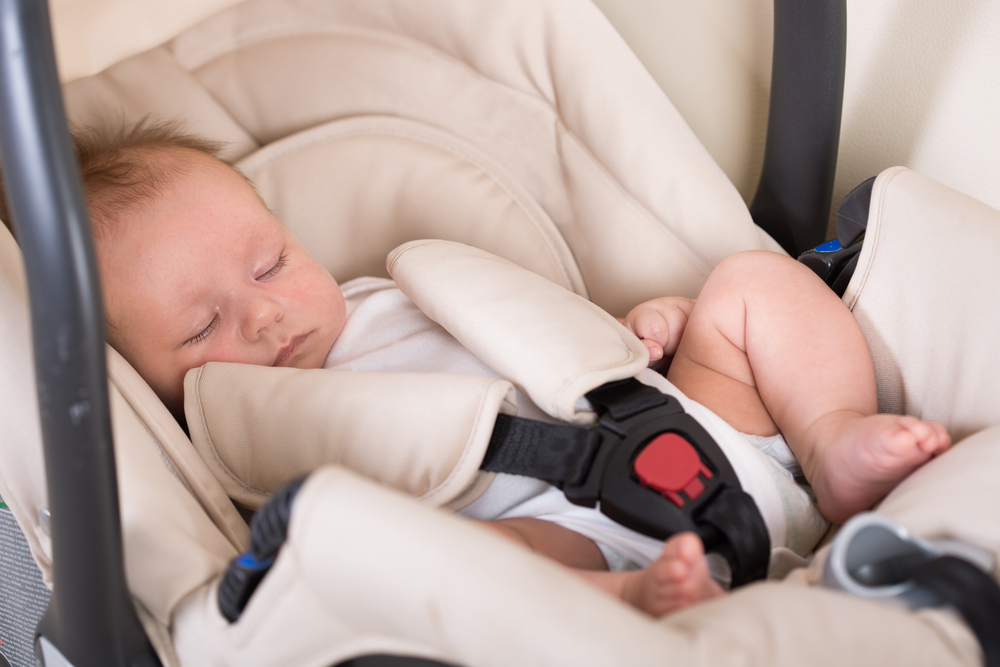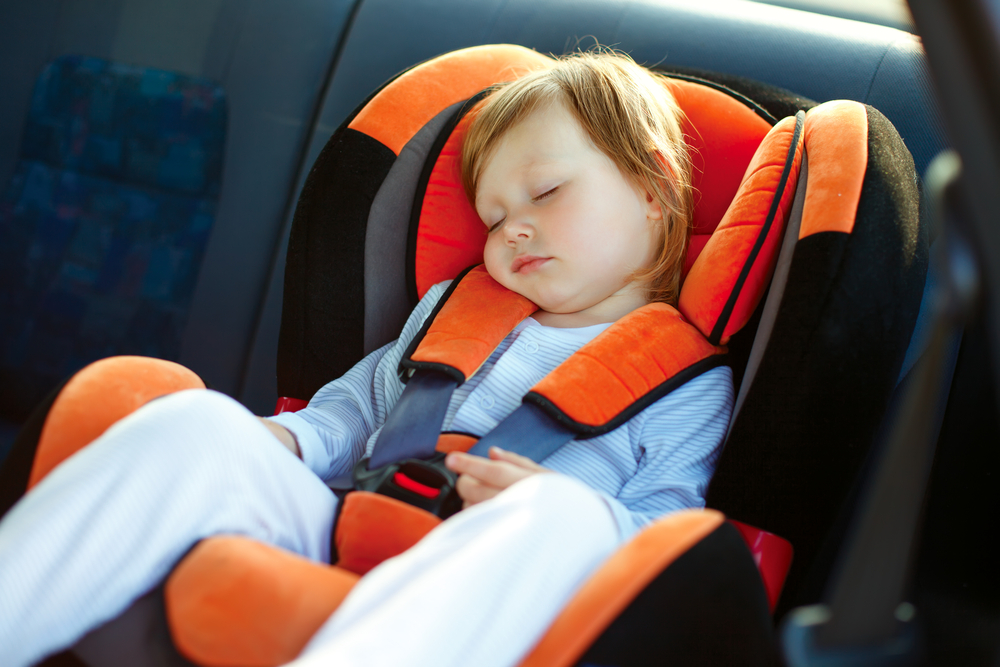If you’re a parent on the go, you’ll be sharing lots of car trips with your teeny tot. Car journeys are an important part of our day-to-day life, and car seats are an essential safety precaution for little ones. Whether it’s a quick drive to lull your babe to sleep or a full-blown road trip, our expert advice ensures they’re safe on the road.
Here, you will find out all about car seat safety laws and regulations as well as the answers to some of the most frequently asked car seat safety-related questions. We want you to feel confident that your little one is as safe as can be for every journey. Buckle up and let’s get going.
Car seat law
The most important thing to remember is, by UK law, all children must use car seats until they’re 135 cm tall or until the age of 12 (whichever comes first). Depending on the type of car seat you have, your baby must remain rearward facing until either 9 months old or 15 months old. However, don’t rush as the safest way to travel in a vehicle with your baby is with them rear-facing in their car seat.
Car seat regulations
When it comes to car seat safety, the first job on your list is to get a safe and reliable car seat that complies with the current car seat regulations. There are two car seat regulations in the UK, R129 and R44. Both are safe to use under UK car seat laws but R129 is the most recent and safest car seat regulation..
R129
The R129 standard was introduced in 2012 to make travel for babies and children even safer. It follows more detailed testing than R44 for improved head and neck protection, to keep babies rear-facing for longer and to make it easier for parents to choose the right size seat.
With R129 (or i-Size) car seats, you must:
- Choose the correct size seat depending on your child’s height, not weight
- Use ISOFIX to secure the seat to a vehicle
- Keep your child rear-facing until at least 15 months old (75cm).
We’ll let you in on a little secret – your little one’s height can actually be worked out using their clothes because labels usually have the height on them. So, to determine which car seat your little one needs and if you choose an R129 (i-Size) standard car seat, like our Maxi Cosi CabrioFix you will determine the right seat based on your child’s height.
These seats don’t have specific categories, unlike R44 seats, but can be organised by height restrictions, as follows:
Phase 1 i-Size– is an infant car seat suitable from birth to 105cm (approximately 15 months). Some i-Size car seats are suitable from birth to around 4 years.
Phase 2 i-Size– is a children’s car suit suitable from 100-135cm (approximately 4-12 years).
These car seats all require ISOFIX to secure them to a vehicle. It became compulsory for all new cars to be fitted with ISOFIX points in 2014 but many cars before that have them. Some car seats come with ISOFIX built-in, whereas others (usually infant carriers) need a separate ISOFIX base.
R44
Car seats that are categorised based on a child’s weight are R44 standard car seats, like our Maxi Cosi CabrioFix car seat. This is an older standard in the UK but still relevant. These seats aren’t considered unsafe but they aren’t put through the same rigorous testing as R129.
With R44 car seats, you must:
- Choose the correct size car seat based on weight, not height, and these car seats are categorised by groups
- Fit the seat using ISOFIX or a vehicle seat belt
- Your child can travel forward facing after 9 months (9kg).
R44 car seat groups
Group 0– suitable for babies from birth to 10kg (approximately 6-9 months).
Group 0+– suitable for babies from birth to 13kg (approximately 12-15 months).
Group 0+/1– suitable for babies and toddlers from birth to 18kg (approximately 4 years).
Group 1– suitable for babies from 9-18kg (approximately 9 months to 4 years).
Group 0+/1/2– suitable for babies, toddlers and children from birth to 25kg (approximately 6 years).
Group 2– high back booster seat suitable for children from 15-25kg (approximately 4-6 years).
Group 0+/1/2/3– suitable for babies, toddlers and children from birth-36kg (approximately 11-12 years).
Group 2/3 – high back booster seat suitable for children from 15-36kg (approximately 4-11 years).
Group 3– a booster cushion suitable for children from 22-36kg (approximately 6-11 years).
Use these weight groups and i-Size size guides to determine when it is time to change your car seat to ensure they are safe and have the right size seat for them as they grow.
How long can a baby be in a car seat?
One of the most frequently asked car seat safety-related questions is how long can a baby be in a car seat? A baby shouldn’t be in a car seat for longer than 2 hours as it can cause breathing difficulties. If you’re going on a long journey, make sure you stop and allow your baby regular breaks out of their car seat.
When can a baby face forward in a car seat?
The safest way to travel in a car with a baby is with them in a car seat, in the back of the car, rear facing. With some R44 car seats, you can turn your baby around to forward facing at around 9 months old, others are 15 months old and with all R129 car seats, you can turn them around at 15 months old.
We recommend keeping your baby rear-facing for as long as possible and not rushing the process as it is safer to have them rear-facing.
What should a baby wear in a car seat?
Because the straps of the car seat should be tight to your baby, only allowing enough space for one or two fingers to slip underneath, you should remove any bulky clothing or blankets before buckling your baby in.
Wearing big, thick coats, snow suits or blankets under the harness means the harness won’t be as tight as it would be without them on. Plus, wearing all those layers can cause a baby to overheat. A better option is to take off the bulky layers, strap them in tightly, and then drape a loose blanket over them if needed.
How to secure a baby in a car seat
As mentioned above, make sure you strap your little one in tight enough so you can only get 1 or two fingers between that and your baby. If you have noticed your baby’s head dropping forward during a car journey, we know it can be an uncomfortable thing to look at and you probably wanted to pull over somewhere safe immediately to sort it out.
To stop this from happening, make sure they are properly strapped in, use a recline setting if your car seat has one and make sure the headrest is properly adjusted and surrounding your baby’s head.
How to keep a car seat clean
Last but not least, keeping the car seat clean isn’t just to keep it looking lovely and fresh but it keeps your baby safer too. Always read the manufacturer’s instructions for more detailed cleaning tips but most car seat fabrics are removable and can be put in the washing machine.
If you want to do this, make sure you choose a low setting and use gentle detergents. If you want to spot clean or clean by hand, simply use a bowl of warm, soapy water and a soft cloth to brush and dab the car seat clean. For stains, always pre-treat before washing using stain remover products. For the straps and harness, use warm, soapy water and allow everything to air dry before using it again.
We hope you can go on many happy car journeys with your little one, feeling more confident that you understand the rules and guidelines of keeping a baby safe in a car seat. Always remember to choose a car seat that is the correct size for your little one, keep them rear-facing for as long as possible, don’t cover them in thick layers and strap them in tightly.



